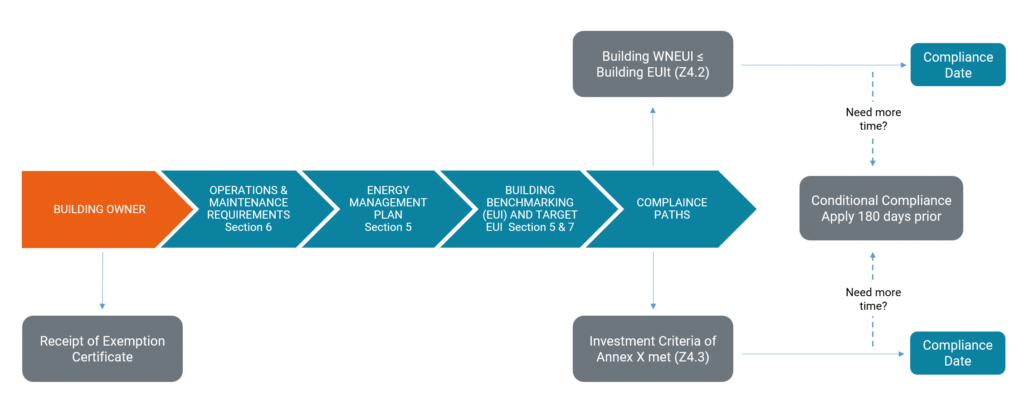Clean Buildings Performance Standard
The Clean Buildings Performance Standard is mandatory for Tier 1 buildings located in the state of Washington. A Tier 1 building (formerly known as covered commercial building) is a building where the sum of nonresidential, hotel, motel and dormitory floor areas exceeds 50,000 gross square feet, excluding the parking garage area. Compliance and reporting for Tier 1 buildings begins June 2026 for buildings greater than 220,000 sq ft.

On March 25, 2022, Governor Inslee signed the Clean Buildings expansion bill into law. The expansion applies to buildings 20,000 square feet or larger, adding a new second tier that includes multifamily buildings.
The first phase of this expansion will require reporting on benchmarking, implementation of energy management plans and operations and maintenance programs for all Tier 2 buildings. Compliance and reporting for Tier 2 must be submitted by July 1, 2027.
| Tier 1 buildings | Tier 2 buildings |
|---|---|
| Buildings greater than 50,000 square feet | Buildings 20,000 to 50,000 square feet |
| Must comply with the Clean Buildings Performance Standard | Benchmarking, EMP and O&M program required |
| Mandatory compliance begins in 2026 for buildings over 220,000 square feet | Mandatory reporting July 1, 2027 |
| Rules are established and can be found in WAC 194-50 | Rules will be complete by Dec 2023 |
| Does not include multifamily residential buildings | Includes multifamily residential buildings greater than 20,000 square feet |
Federal buildings and buildings belonging exclusively to Federally Recognized Tribes are not required to comply with the standard.
Compliance Deadlines
Tier 1 buildings must meet the following reporting schedule:
- June 1, 2026 – 220,001+ square feet
- June 1, 2027 – 90,001- 220,000 square feet
- June 1, 2028 – 50,000- 90,000 square feet
On Oct. 13, 2021, Building Owner Notification Letters were mailed. Each letter included instructions on how to log into the Clean Buildings Portal to verify the accuracy of the building’s characteristics and to submit required compliance documentation. If a building owner of a Tier 1 covered building does not receive a notification, this does not release them from legal obligation to comply.
Tier 1 — Ready to get started?
Tier 1 covered buildings may submit an Application for Exemption Certificate where the building meets at least one of the exemption criteria outlined in section Z4.1 of the standard. Exemption certificates for approved buildings are only valid for the current compliance review cycle.
Applications for exemptions may be submitted no sooner three years prior to the compliance date and submitted to Commerce no later than 180 days prior to the compliance date.
If buildings meet one of the exemption criteria in RCW 19.27A.210(7)(c), building owners can now apply for an exemption three years prior to their scheduled compliance date.
- Tier 1 buildings over 220,000 sq. ft. can apply for an exemption beginning on June 1, 2023.
- Tier 1 buildings over 90,000 sq. ft. can apply for an exemption beginning on June 1, 2024.
- Tier 1 buildings over 50,000 square feet can apply for exemption beginning on June 1, 2025.
Within six months before the compliance date, building owners who have received exemption approval must certify that the building still meets the eligibility qualifications for the exemption and that there have been no material changes to qualifying conditions. Commerce will provide a one-page declaration for exempted building owners to sign.
A list of acceptable documents can be found in:
- Specific exemption guidance documents in the Clean Buildings Library OR
- Clean Buildings Performance Standard, Annex Z6.7(4)
The application for exemptions can be found through the Clean Buildings Portal.
This is a process-oriented standard with long lead times to help keep compliance costs down. It is most cost-effective to start the compliance process early.
- If you do decide to start early, you may be eligible to apply for the Early Adopter Incentive Program.
- Timelines will vary. Click here to review an example timeline for buildings over 220k square feet.
The Clean Buildings Performance Standard consists of ASHRAE Standard 100-2018 and state amendments WAC194-50. Follow the link below to gain access to a copy of the integrated standard published by ASHRAE.
a. Watch training videos and presentations on the Clean Buildings Performance Standard.
Start with Clean Buildings 101 or the WSU RCM Webinar: Efficiency through the Clean Buildings Performance Standard.
b. Sign up for the Environmental Protection Agency (EPA) training series on using Energy Star Portfolio Manager for benchmarking.
c. Explore the Smart Building Center remote learning library.
d. Explore the Clean Buildings Support and Resources page for tools and resources to assist with compliance.
- Compliance with the standard can get complicated. Plan ahead and understand supporting roles needed for compliance. Compliance requires a qualified person and may require a qualified energy auditor. Click here for defined roles and responsibilities.
- If you’re interested in earning your Building Operator Certification Level II to gain one of the accepted certifications to be a qualified person visit https://www.theboc.info/find-training/
To begin the compliance process, create a profile in the state’s Clean Buildings Portal. The Clean Buildings Portal is where you will submit compliance documentation and can apply for the Early Adopter Incentive Program.
Follow the instructions in the Building Owner Notification letter. You will receive information on how access to the Portal. If you did not receive a notification letter with a code to access the Portal, please complete this form to request a copy of the letter. Review the videos and guides to help you create a SAW account.
- Establish your building performance metric by benchmarking the building. Are you unfamiliar with benchmarking? Review this document to learn more about the basics of benchmarking.
- Create an account with the Energy Star Portfolio Manager (ESPM).
- Contact your utility provider(s) to integrate your building into ESPM. Understand your utility providers’ role in compliance.
- Utilities are required to provide energy consumption data to building owners upon request. Large utilities (greater than 25,000 customers) are required to provide this data using ESPM’s automated upload protocol. Smaller utilities are to provide the data to building owners in an Excel document, meeting Energy Star Portfolio Manager specifications (see RCW 19.27a.170).
Benchmarking will help to determine which compliance path to pursue. Establish the weather normalized energy use intensity (WNEUI) for each building in ESPM. Create the energy use intensity target (EUIt) for the building in accordance with Annex Z, Section Z6.2. For assistance on how to determine your building’s EUIt, select this guide sheet, and review the Building Activity Site Energy Targets and definitions.
Note: Buildings unable to develop a target EUI shall pursue compliance in accordance with the investment criteria performance metric and are not required to create an ESPM.
Develop and implement the Energy Management Plan (EMP) and associated Operations and Maintenance Program (O&M) for each building as outlined in Sections 5 and 6 of ASHRAE Standard 100-2018 and WAC 194-50. This step can happen concurrently with benchmarking.
The EMP and O&M program are mandatory requirements for all covered buildings. Implementation of these requirements can begin at any time. The O&M program requirements must be implemented 12 months prior to the mandatory compliance date.
Tip: Designate an Energy Manager and identify your qualified person. A qualified person requires specific expertise and certification. Select this link for defined roles and responsibilities.
The building owner of a Tier 1 covered building must report compliance with the standard to Commerce in accordance with the initial compliance schedule and every five years thereafter.
Need more time to comply?
Conditional compliance is a temporary compliance method that can be applied to avoid the penalty if the EUIt or Investment Criteria will not be met by the scheduled compliance date. See Annex Z4 for more details. Application for conditional compliance must be submitted a minimum of 180 days prior to the scheduled compliance date.
Commerce is authorized to impose administrative penalties upon building owners who fail to submit documentation demonstrating compliance. Failure to submit appropriate documentation by the scheduled reporting date will result in progressive penalties by legal notice.
- See Annex Z5 to learn more about violations, assessment of administrative penalties, mitigation and review of penalty decisions.
- Find the Clean Buildings Performance Standard Penalties Estimator here, or on the Support and Resources page.
Paths to compliance

Paths to compliance – written guides and videos:
a. Compliance through exemption (PDF)
b. Compliance by meeting the EUIt (PDF) and video
c. Compliance through investment criteria (PDF) and video
d. Conditional compliance granted by the compliance date (PDF)
Paths to compliance – flow charts:
a. Compliance paths (PDF)
b. Compliance by meeting EUIt (PDF)
c. Compliance through investment, with a measurable EUIt (PDF)
d. Compliance through investment, without a measurable EUIt (PDF)
Quick links
Compliance deadlines
Tier 1 buildings must meet the
following reporting schedule:
June 1, 2026
More than 220,000 sq. ft.
__________________________________
June 1, 2027
More than 90,000 sq. ft. but less than 220,001 sq. ft
__________________________________
June 1, 2028
More than 50,000 sq. ft. but less than 90,001 sq. ft
Need help?
Submit any questions you may have using the Customer Support Form.
